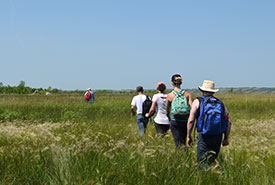How to conduct your own soundwalk

Volunteers have dropped off all sign posts and signs at their designated installation sites and are heading back to the central meeting area for a well-deserved break. (Photo by NCC)
A soundwalk is a walk where you focus on the sounds around you, and immerse yourself completely in the environment that you’re in.
Soundwalking can be a very rejuvenating and meditative experience. Why not try doing a soundwalk on your next nature excursion? Whether you’re a beginner or a pro, use our tips below to try your very first soundwalk, or lead a group!
Tweet @ncc_cnc your soundwalk experience with #time4nature.
1. Plan a route, or plan to be spontaneous
It might be a good idea to map out your soundwalk route with a smartphone if you have a place in mind. This is especially helpful if you’re leading a group soundwalk. Or, you can be a little bit more spontaneous and do a soundwalk anywhere on a nature outing. Research shows that soundwalks in nature are especially beneficial to participants’ mental, physical and emotional well-being!
2. Connect with your environment
Set aside at least 30 seconds with no talking — to really focus on the sounds around you. If you’re with a big group or it’s hard to get everyone to stay quiet, you can stagger the soundwalk in different stages, with shorter increments to listen, discuss and then listen and discuss again.
3. Close your eyes
Step out of your comfort zone and try closing your eyes during the soundwalk. Not using your vision can greatly accentuate the experience, requiring you to rely on your senses of hearing and touch. Some people may feel especially vulnerable with their eyes closed, but this allows for a heightened sense of concentration, and potentially a new and different type of connection with nature.
4. Make it thought-provoking
Consider recording the sounds you hear during your walk, using a recorder or smartphone, and try to identify the sounds later. Which bird sings that tune? What type of frog was that croaking by the pond?
5. Reflect, remember and re-do!
Like a lot of nature activities, soundwalks can be addictive, especially if done frequently and used as a reflective or social activity. Reflect on the soundwalk you just did; would you rather do an individual or group soundwalk next time? What were some of the most memorable sounds? Most importantly, where will your next soundwalk take you?
Tweet @ncc_cnc your soundwalk experience with #time4nature.


